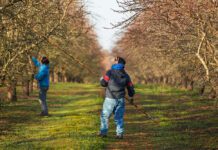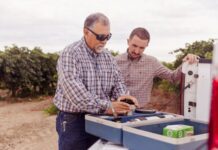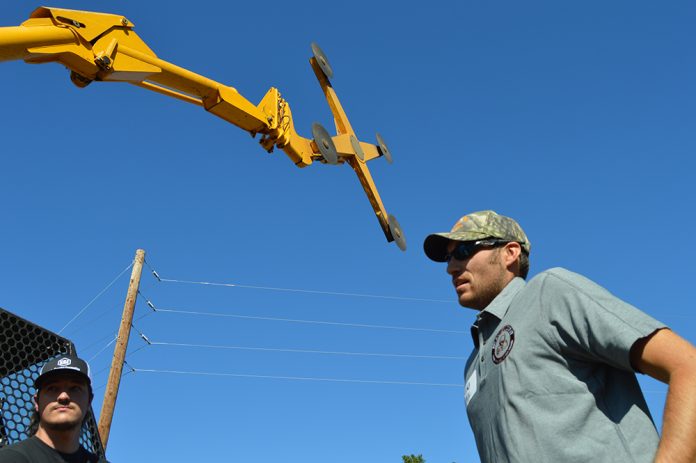
Labor and cost saving options were front and center at the 2023 Nut Growers Society (NGS) Summer Tour on August 2 in Albany, Ore., with demonstrations of an intelligent sprayer and a mechanized pruner among morning highlights.
In addition, growers were provided information on pest management strategies in an afternoon session that included three hours of presentations. And hazelnut industry suppliers and affiliated industries packed the Knife River Training Center with booths and equipment.
The day started with four breakout sessions, two of which were all about cost and labor savings.
Oregon State University Extension Plant Pathologist Jay Pscheidt said that in grapes and several other crops, growers were saving up to 70% on material costs when using the Intelligent Spray System, which sprays only when plant canopy is present.
And, he said, a reduction in spray volume provides labor savings by minimizing the number of fill-ups during a spray operation. “You’re saving on labor because you aren’t going back to refill constantly,” Pscheidt said. “And you’re saving on water.”
The Intelligent Spray System, which is being sold by Smart Guided Systems, was developed by USDA-ARS’s Application Technology Research Unit (ATRU) with competitive funds from the National Institute of Food and Agriculture.
The system has 10 years of research and field testing that shows it increases precision and accuracy while reducing pesticide use when chemicals are applied. Studies at USDA-ARS ATRU, The Ohio State University, Oregon State University and University of Tennessee show a reduction in pesticide use of 47% to 73% with comparable insect control efficiency and equal or better disease control, according to Pscheidt.
The system is expected to be particularly beneficial when treating young orchards, said Brent Warneke, faculty research assistant.
“It adjusts the amount of spray it applies in real time based on the canopy density that it sees with a laser sensor,” Warneke said. “In a young orchard, you could see 70% in savings on materials.”
The system, which can fit onto any spray rig, includes a fan that blows air on the laser to keep off dust, and a GPS to track the speed of the tractor and synchronize spray output with what the laser is seeing. “And a very important component of the system is individual solenoid valves at each nozzle body that pulse 10 times per second and are able to adjust how much time they’re open in each one of those pulses,” Warneke said.
The system operator can set viewing angle, viewing distance and other parameters for each nozzle with a tablet computer, allowing an operator to change settings for different crops, Warneke added.
Mechanical Pruner
A second breakout session included a presentation on a mechanical pruner.
Matt Miller of Miller Hazelnut Farms in Hubbard, Ore., said mechanical pruners like his have been around for 40 or 50 years. When he purchased one five years ago, however, he said he was only the sixth person in Oregon to buy one. He connects the pruner, manufactured by TOL Inc., to a John Deere 6210 tractor.
“We prune anything from five-year-old trees to 80-year-old Barcelona and everything in between with this,” he said.
The pruner’s four saws cut multiple wood diameters, he said, with the smaller-diameter wood easier to cut and faster to get through.
“This will cut two- to four-inch diameter wood all day,” he said. “And on average, if you’re cutting two- to four-inch stuff, you can do 30 to 40 acres a day pretty easily.”
Miller noted he was cutting an orchard for a friend that had six-inch wood and he still got through six acres in 16 hours. “I was in creeper gear,” he said, “as slow as this thing would go.”
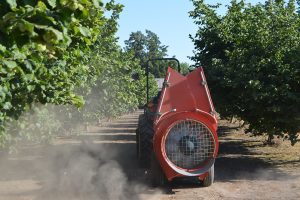
The most acres he has ever pruned in a day was “75 or 80 acres” of a prune orchard, he said. “But that was wood the size of your thumb,” he said, “pretty small diameter stuff.”
The pruner includes four circular saws attached to a long arm that can extend up to 30 feet. “I can top from 2 feet to about 20 feet,” Miller said. “And then I can flip it on its back to skirt the underneath of a young tree.”
Miller said he likes to keep aisles as clean as possible. “So, we do a vertical cut to make the aisle about 8 to 10 feet wide roughly as high up as we can go so there is a lot of light getting from the top to the bottom, and we get better spray coverage.”
Maintenance on the pruner is relatively simple, he said. “The main thing is there are just a lot of pivot points to grease,” he said. “And the four saw blades are powered by belts, so you have to keep the tension on those. If I’m cutting small, I’ll go a day or two without adjusting them. But if I’m cutting big wood, I make sure to check them in the morning and at lunch, because you can fry a set of belts on this pretty quick if you’re not careful.
“But other than that, everything is hydraulic,” he said. “The tractor PTO runs a hydraulic pump that runs the blades and the cross. And the up-and-down and the angle of the boom is run off the hydraulics remote on the tractor.”
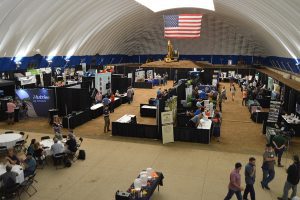
Soil Health
A third breakout session was all about soil health.
Shannon Cappellazzi, director of research for the Salem-based GO Seed, said soil health is key to maximizing yield potential in hazelnuts. And, she said, the single biggest activity growers can do to improve soil health is to keep soil covered with living tissue.
“The No. 1 way that we feed organisms in the soil is by having living plants,” Cappellazzi said. “When we have living plants in a system, we are able to feed the microbial community.”
She added the more diverse and abundant a soil’s microbial community, the better soil functions.
To increase cover crop usage in hazelnuts, Cappellazzi said that she, OSU Extension Orchard Specialist Nik Wiman and OSU Statewide Soil Water Quality Extension Specialist Abigail Tomasek have a grant proposal titled “Overcoming Barriers to Cover Crop Use in Hazelnut Production” in which they plan to interview hazelnut growers who use cover crops.
“There are some really practical reasons why people manage a bare orchard floor,” she said, including that growers like to harvest from a bare floor and have harvest equipment designed for bare-floor harvest. Also, she said, growers are concerned that vegetation on orchard floors increases pest pressure.
But, Cappellazzi said, there are many hazelnut growers in the Willamette Valley who successfully utilize cover crops in their operations.
“So, what we are doing is we’re talking to them about what they’re seeing as far as the benefit,” she said. “Why do they think that it is useful to have those [cover crops]? And what are they doing to make that work? What do those pest pressures look like? What does the economic situation look like?”
The project also includes taking soil samples to gauge whether soil under cover crops is actually healthier in terms of its ability to function.
Overall, James McDonald, president of the Nut Growers Society, characterized the 2023 NGS aHSummer Tour as a huge success.
“It’s been a great day,” he said in late afternoon. “We had a lot of good participation and had great enthusiasm.
“There has been a lot of research disseminated today, which has been great to learn about,” McDonald said. “I’m looking forward to getting back to the orchard tomorrow with some new knowledge.”
Approximately 600 attended the event, according to the Hazelnut Industry Office.




